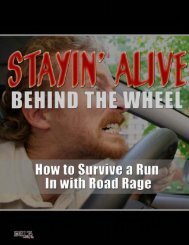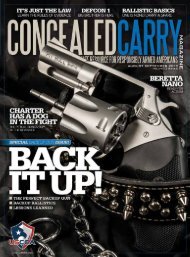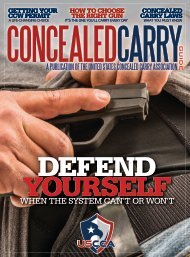Download This Issue - US Concealed Carry
Download This Issue - US Concealed Carry
Download This Issue - US Concealed Carry
Create successful ePaper yourself
Turn your PDF publications into a flip-book with our unique Google optimized e-Paper software.
Dred Scott v. Sanford, 60 <strong>US</strong> (19 How.)<br />
393, 417 (1875). The court held that if<br />
freed blacks were citizens they would<br />
have the rights of all citizens, including<br />
the right “to carry arms wherever they<br />
went.”<br />
<strong>US</strong> v. Cruickshank, 92 <strong>US</strong> 542 (1876).<br />
William J. Cruickshank and two other<br />
defendants were convicted under the<br />
Enforcement Act of May 31, 1870 for<br />
conspiracy to deprive (black) citizens of<br />
their right under the First Amendment<br />
“to peaceably assemble” and their right<br />
under the Second Amendment “to keep<br />
and bear arms.” After being forcibly<br />
disarmed, the black citizens were murdered.<br />
The court conceded that both<br />
rights existed as privileges and immunities<br />
of citizenship, but that the Bill<br />
of Rights “means no more than (those<br />
rights) shall not be infringed by (<strong>US</strong>)<br />
Congress.” Even Cruickshank’s attorney<br />
conceded, “The right of self-defense is a<br />
natural right; and the right to keep and<br />
bear arms for that purpose cannot be<br />
questioned.”<br />
Presser v. Illinois, 116 <strong>US</strong> 252 (1886)<br />
was nothing more than an affirmation<br />
that a private army could be required<br />
to obtain a permit before parading on<br />
a public street while armed. The Court<br />
also held, “It is undoubtedly true that all<br />
citizens capable of bearing arms constitute<br />
the reserved military force or reserve<br />
militia of the United States as well<br />
as of the states, and in view of this prerogative<br />
of the general government…<br />
the States cannot…prohibit the people<br />
from keeping and bearing arms.”<br />
<strong>US</strong> v. Miller, 307 <strong>US</strong> 174 (1939). <strong>This</strong><br />
is the only twentieth-century Supreme<br />
Court case on the Second Amendment.<br />
It deals not with individual’s right to<br />
private arms, which the Court affirmed,<br />
but what type of arms are protected.<br />
Jack Miller was charged with transporting<br />
a sawed-off shotgun in interstate<br />
commerce without paying the appropriate<br />
tax on such weapon under the<br />
National Firearms Act. The trial court<br />
dismissed the charges because the Act<br />
violated the Second Amendment to the<br />
<strong>US</strong> Constitution. Jack Miller departed.<br />
“Guard with jealous attention<br />
the public liberty. Suspect every<br />
one who approaches that jewel.<br />
Unfortunately, nothing will<br />
preserve it but downright force.<br />
Whenever you give up that force,<br />
you are ruined.”<br />
— Patrick Henry, during Virginia’s<br />
ratification convention, (1788)<br />
The federal attorney appealed directly<br />
to the Supreme Court. No one presented<br />
any evidence or arguments on behalf of<br />
Miller. The Court did not inquire whether<br />
Miller was a member of some organized<br />
Militia, but held in the absence of<br />
evidence it was unable to take judicial<br />
notice that the weapon was appropriate<br />
for the military and, thus, subject<br />
to Second Amendment protection.<br />
The Court specifically affirmed that all<br />
constitutional sources, “show plainly<br />
enough that the militia comprises all<br />
males physically capable of acting in<br />
concert for the common defense. These<br />
men were expected to appear bearing<br />
arms supplied by themselves and of the<br />
kind in common use (by the military) at<br />
the time.”<br />
Our Constitution is the first in the<br />
world to guarantee in writing that no<br />
person shall be deprived of life, liberty,<br />
or property without due process of law.<br />
Our Founders considered that the right<br />
to protect one’s life was a natural, Godgiven<br />
right. “The right of self-defense<br />
is a natural right; and the right to keep<br />
and bear arms for that purpose cannot<br />
be questioned.” 12 Perhaps this is the priority<br />
our citizens and our government<br />
should work harder to protect.<br />
A final footnote<br />
There is a temptation to think that<br />
because we now have more advanced<br />
technology we must now be smarter<br />
or that our social conditions are<br />
somehow different. As one studies our<br />
Constitution, its history, and values, it<br />
becomes clear that there is no new wisdom.<br />
The Founders were dealing with<br />
many of the same social issues we face<br />
to this day, and their thoughts on what<br />
made sense then are often equally valid<br />
today. The wisdom from their time has<br />
been born out by the modern scientific<br />
data of our time. n<br />
[ Bob Heinritz, an honors graduate in<br />
management and law, is a member of the<br />
Bar in Arizona, Illinois, and Missouri. A<br />
former trial lawyer, he is now a business<br />
attorney and management consultant<br />
who specializes in strategic planning,<br />
productivity, business turnarounds, and<br />
preventive law. ]<br />
1. Thomas Jefferson, Proposed Virginia Constitution (1776), Jefferson Papers<br />
344, J. Boyd, ed. 1950<br />
2. See, for example: [1] Don B. Kates, Henry E. Schaffer, PhD, John K. Lattimer,<br />
MD, George B. Murray, MD, and Edwin W. Cassem, MD, “Guns and Public<br />
Health: Epidemic of Violence, or Pandemic of Propaganda?” 62 Tennessee<br />
Law Review 513, Spring 1995; [2] March 1994 and [3] May 1994 Journal of<br />
the Medical Association of Georgia, Medical Association of Georgia, 938<br />
Peachtree St, Atlanta GA 30309, (800) 282-0224; [4] Doctors For Integrity In<br />
Research & Public Policy, Edgar A. Suter, MD, Chair, 5201 Norris Canyon Rd,<br />
Ste 140 San Ramon CA 94583; [5] Doctors for Responsible Gun Ownership,<br />
Claremont Institute, 250 W. 1st St, Ste 330, Claremont CA 91711, (909) 621-<br />
6825<br />
3. Ibid at 136<br />
4. Ibid at 140<br />
5. Ibid at 144<br />
6. Mary Zeiss Stange, “Arms and the Woman: A Feminist Reappraisal,” Guns:<br />
Who Should Have Them, David B. Kopel, Ed., Prometheus Books 1995 at 15<br />
7. Edgar A. Suter, MD, 5201 Norris Canyon Rd, Ste 140 San Ramon CA 94583;<br />
“Doctors for Responsible Gun Ownership,” the Claremont Institute, 250 W.<br />
1st St, Ste 330 Claremont CA 91711, (909) 621-6825; Medical Association of<br />
Georgia, 938 Peachtree St, Atlanta GA 30309, (800) 282-0224<br />
8. <strong>This</strong> article was originally written in 1996; HCI has since become the Brady<br />
Center to Prevent Gun Violence<br />
9. 10 <strong>US</strong>C. 311(a)<br />
10. 32 <strong>US</strong>C. §105[a] [1].<br />
11. See That Every Man Be Armed, The Evolution of a Constitutional Right, Stephen<br />
P. Halbrook, the Independent Institute 1984; pp. 146-152, in which<br />
Representative John A. Bingham, draftsman of the 14th Amendment, and<br />
Senator Thomas M. Norwood explicitly stated on the record in Congress<br />
that the specific purpose of the 14th Amendment was to apply the protection<br />
of the first eight amendments of the Bill of Rights to actions against<br />
citizens by states.<br />
12. <strong>US</strong> v. Cruickshank<br />
30<br />
<strong>US</strong>CONCEALEDCARRY.COM n CONCEALED CARRY MAGAZINE n JULY 2008
















